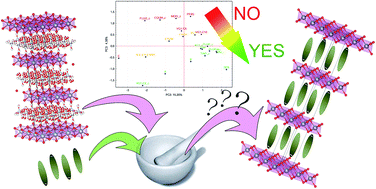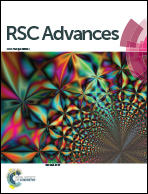Rationalization of liquid assisted grinding intercalation yields of organic molecules into layered double hydroxides by multivariate analysis†
Abstract
The Liquid Assisted Grinding (LAG) method for the fast and facile preparation of organic-intercalated Layered Double Hydroxide (LDH) nanocomposites allowing the production of low cost, stable and efficient functional materials, is here employed to rationalize the features of the organic compounds that most likely undergo easy intercalation. LAG method was exploited to determine in a short time which molecules can be successfully intercalated into LDH. A straightforward rationalization of the intercalation yield results was not possible since no individual feature (such as bulkiness or pKa) could alone describe the intercalation behaviour of the whole set of molecules. Therefore, Principal Component Analysis (PCA) together with the use of molecular descriptors to classify molecules, were mutuated from the chemometric approach, widely used in analytical chemistry and applied successfully, for the first time, to a novel area of materials science. A set of molecular descriptors were chosen to cover different features of the molecule (physicochemical, topological, geometrical etc.) and then screened by statistical methods to understand which descriptors affected the intercalation yield. Then PCA allowed us to highlight the presence of various mechanisms, involved in the LAG intercalation and to separate the samples along PC3 as a function of yield. Finally, the classification tree method allowed us to understand the various mechanisms of intercalation and to classify molecules in groups, related to their yield. These groups can be used to estimate the expected yield as a function of the molecular descriptors. The molecules more apt to LAG have medium–low molecular weight, high flexibility and low refractivity. Conversely large and hydrophobic molecules and, surprisingly, small but rigid molecules have a small success rate concerning LAG intercalation. The behaviour of this last class of molecules, that should be in principle easily intercalated by LAG but which was identified by the present study as a difficult case, was thus tested using two molecules and the prediction of the chemometric study was confirmed.



 Please wait while we load your content...
Please wait while we load your content...